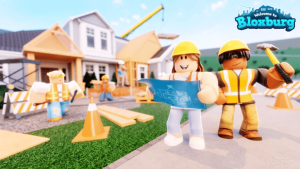Roblox Welcome to Bloxburg
| Status | Active |
|---|---|
| Active Players | 23,681+ |
| Favorites | 13,745,923+ |
| Visits | 9.5B+ |
| Created | 11/4/2014 |
| Server Size | 12 |
| Genre | Roleplay & Avatar Sim |
| Subgenre | Life |
Welcome to Bloxburg[1] is a Roblox roleplay & avatar simulation game with life-simulation and building mechanics, where players create homes, work jobs, and roleplay daily life while exploring the city of Bloxburg. This game is developed by Coeptus (now under Bloxburg Development) and has been visited billions of times and recently updated. The total number of visits are about 9.5+ Billion and more than 13,745,923 players have added it to their favorites. Current active players are around 23,681. Server size is 12 and Genre is Roleplay & Avatar Sim with a Life subgenre. Voice Chat and Camera features are supported. The game was created on 11/4/2014 and last updated on 9/28/2025. The more jobs you work or rare items you collect, the more in-game currency or rewards you can earn, which allows you to upgrade houses, buy vehicles, and prepare for bigger building projects or roleplay expansions. The game also gives event rewards periodically, uses a “friend boost” system, and has a gifting/share system. As of now, there are (no / some) active codes (promo codes) for Welcome to Bloxburg, depending on the event status. “Lost Bones” equivalent in this game is the roleplay/work progression quests, where you have to level up in different jobs or complete building tasks scattered across the city. After completing all requirements, returning to the related NPC or menu confirms the completion and unlocks new rewards. The NPC text will confirm completion.[1]
Core Gameplay & Mechanics
[edit | edit source]1. Build Mode & Housing
[edit | edit source]One of the biggest draws of Bloxburg is how flexible and rich the building system is.
- Plot & House Building:
- Every player gets a plot of land to build on. You can place walls, floors, furniture, windows, roofs, etc.[2]
- Many players build not just homes but restaurants, shops, parks, themed builds, roleplay spaces, etc.[2]
- Because the build system is robust, custom houses can range from modest homes to elaborate mansions or themed environments.[3]
- Customization & Furniture:
2. Work & Economy
[edit | edit source]To fund building, buying items, and maintaining life functions, you need money. That’s where jobs come in.
- Work System:
- Players choose from various jobs in Bloxburg to earn money. Each job has tasks or mini-activities that the player completes.[3]
- As you do tasks, you can level up in that job, which increases your earnings per task.[4]
- Some example jobs:
- Mechanic (Mike’s Motors): repairing vehicles, changing oil, painting, replacing tires.[4]
- Other jobs include pizza delivery, cashier, janitor, fisherman, ice cream seller, etc.
- Income Uses:
- Buying building materials and furniture
- Paying for utilities/game systems (depending on design)
- Upgrading home components, customizing appearance
- Cars, vehicles, decorative items
3. Avatar & Daily Needs/Mood
[edit | edit source]To make it feel like “living a life,” Bloxburg has systems for needs/moods:
- Mood/Needs:
- The player’s character has mood or status bars (hunger, energy, hygiene, etc.)—you need to take care of those (eat, sleep, bathroom, etc.) to function optimally.[4]
- If some needs are low, tasks might pay less or movement might be slower. (This is typical in such sims, and Bloxburg’s documentation references fulfilling moods.) [4]
4. Vehicles & Mobility
[edit | edit source]- You can purchase vehicles and drive around the city. The city map is large, so being mobile gives access to jobs, shops, etc.[4]
- Cars and vehicles are part of the content at Mike’s Motors and in Build Mode.
5. Roleplay & Social Interaction
[edit | edit source]Because many players enjoy Bloxburg for roleplay, the social side is strong.
- Players can hang out, create stories, build shared spaces, and roleplay in towns/neighborhoods.[2]
- Interactive items, emotes, avatar interactions, and customization enable expressive gameplay.
- Titles above player names:Bloxburg includes titles (like Builder, Designer, etc.). Some titles are special (e.g. “Premium,” “Developer”)[4]
Systems, Updates & Evolution
[edit | edit source]- The game is under active development; the map, UI, and mechanics evolve.
- Changelog shows seasonal/holiday updates (Christmas, New Year, themed decorations) over the years.
- The map has undergone “revamps.” Older versions had boundaries (rock walls) and simpler territory; newer ones use ocean borders, more terrain variety, and more player housing plots.[5]
- Because Bloxburg was bought by Coffee Stain / Bloxburg Development, it likely will see further overhauls or growth under new resources.[4]
Strengths, Challenges & Community Notes
[edit | edit source]Strengths:
- Strong building and customization mechanics appeal to creative/architectural players
- Deep roleplay potential: life simulation attracts people who want more than just action
- Longevity: being around for years and accumulating billions of visits shows stable popularity
- Social / emergent stories form—players create own narratives
Challenges/Weaknesses:
- Performance/lag (especially on mobile) is often a complaint in the community
- Because it’s open-ended, some players feel like after building, there’s less direction—you must self-grow.
- The balance of jobs/pay vs. cost of building items can feel grindy or slow for newer players.
- Updates are slow; big features (like school, hospital, etc.) are often teased but delayed.[4]
- Roleplay engagement fluctuates — players have mentioned quieter servers, especially on non-peak times.[6]
Reference List
[edit | edit source]- ↑ 1.0 1.1 Welcome to Bloxburg - Roblox
- ↑ 2.0 2.1 2.2 House | Welcome to Bloxburg Wiki - Fandom
- ↑ 3.0 3.1 3.2 Bloxburg Wiki Welcome to Bloxburg Wiki - Fandom
- ↑ 4.0 4.1 4.2 4.3 4.4 4.5 4.6 4.7 4.8 Welcome to Bloxburg - Roblox Wiki - Fandom
- ↑ Welcome to Bloxburg Wiki
- ↑ Bloxburg player count is decreasing
